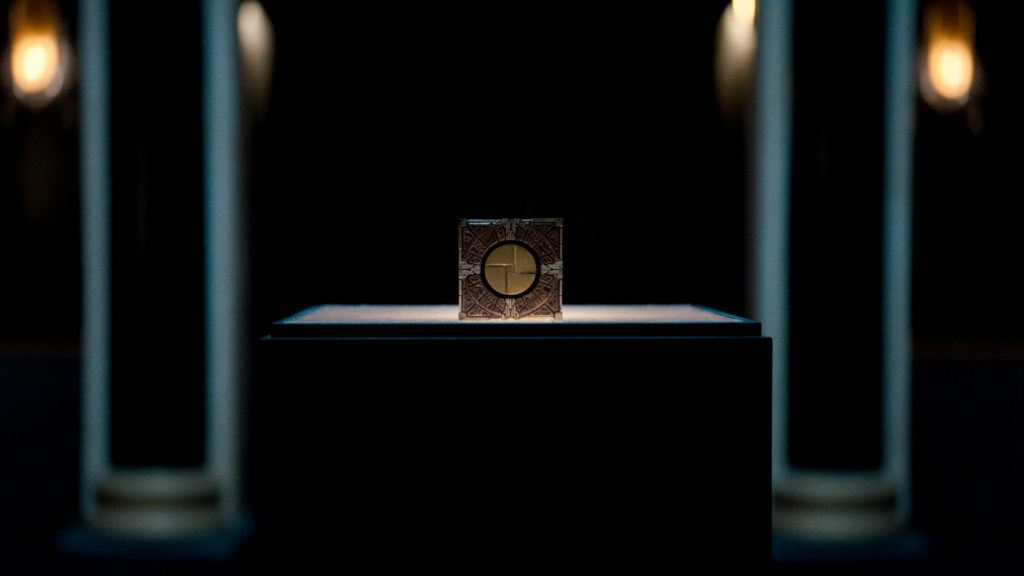Hellraiser (2022)

The Lemarchand Box. © 2022 Spyglass Media Group. All Rights Reserved.
“L’Enfer c’est les autres.” – Sartre
Directed by David Bruckner and written by not one, not two, but three writers—including David Goyer—HELLRAISER partially re-adapts the 1986 Clive Barker novella, The Hellbound Heart. I say “re-adapts” because, while the characters of Frank, Julia and Kirsty have been replaced to accommodate a plot the filmmakers felt would be more relatable for a younger audience. I guess.
Serena Menaker (Hiam Abbass) lures Joey (Kit Clark) to the mansion of a mysterious, generically-named rich man, Voight (Goran Visnjic). There Joey finds one of the Lemarchand puzzle boxes. According to Hellraiser lore, the different configurations of the puzzle box open a door to another dimension or underworld or… something. Not without its price, the box extracts payment in blood—literally—until you reach the final configuration, Leviathan. We come to understand that Serena’s chance encounter with Joey was no accident…
On these ominous portents, Bruckner cuts to a sex scene, and three seconds later, the two—Riley (Odessa A’zion) and Trevor (Drew Starkey)—exit the bedroom to sit for dinner with her brother and friends, who just made Tapas. I did not make this up.
As recovering addict movie characters go, the fact that Riley finds herself persuaded toward the mysteries of the box is a little insulting. She can’t be a normal woman with intellectual curiosity or, like Frank, just plain greedy and hedonistic. She’s got to be broken in some way, or so the Theory of Woman goes in unimaginative horror—the virgin and the whore are the go-tos for the worst of writers. Compare this to Ashley Laurence’s Kirsty, or, for that matter, her spiritual sister, Nancy (Heather Langenkamp) in A NIGHTMARE ON ELM STREET. These were intelligent, resourceful, logical young women.
The clinical banality of Bruckner’s HELLRAISER reminds me of another remake suffering from the same problem. Quantum Leap, based on a television show now thirty years old, likewise tries to couch its human story in the technical details. In the former’s case, we’re supposed to be awed by Voight’s lust for power—never mind what he wants to do with it. I like to think he gets his comeuppance purely for wasting the audience’s time.
While the original film was relatively light on details, it didn’t pretend to give Frank Cotton much ambition beyond his pursuit of carnal pleasure. I’m not really sure what the Evil Businessman really wants to do with it, nor do I much care. But perhaps most disappointing is the main baddie. The Priest (Jamie Clayton), a pincushion-faced demon who promises pleasure and dispenses pain, returns in this incarnation to Barker’s original concept—androgynous form with a (heavily processed) feminine voice.
It’s unfortunate the filmmakers couldn’t think of anything to do with the redesigned Cenobites, other than to update their wardrobe. The thought process, according to interviews with Bruckner, was to move away from dated BDSM, as if that mattered over story. “No no, don’t make it too scary… make it like the Gingerbread Man crossed with Katherine Helmond from Gilliam’s BRAZIL!”
So… Less BDSM more Millennial web dev at a Valley startup? What are they going to do, annoy their victims to death?
In the original film, written and directed by Barker, actor Doug Bradley’s lord of the underworld (credited merely as “Lead Cenobite”) and his disfigured companions each have a conscience that can be bargained with. Like the Greek gods, they’re interestingly imperfect. This Pinhead is, unfortunately, lifeless, thoughtless, surrounded by barely menacing idiots in sleeker costumes—delivering whatever utterances the script requires, including a line straight from the 1987 trailer, “We have such sights to show you!”
It would have been something if they did.